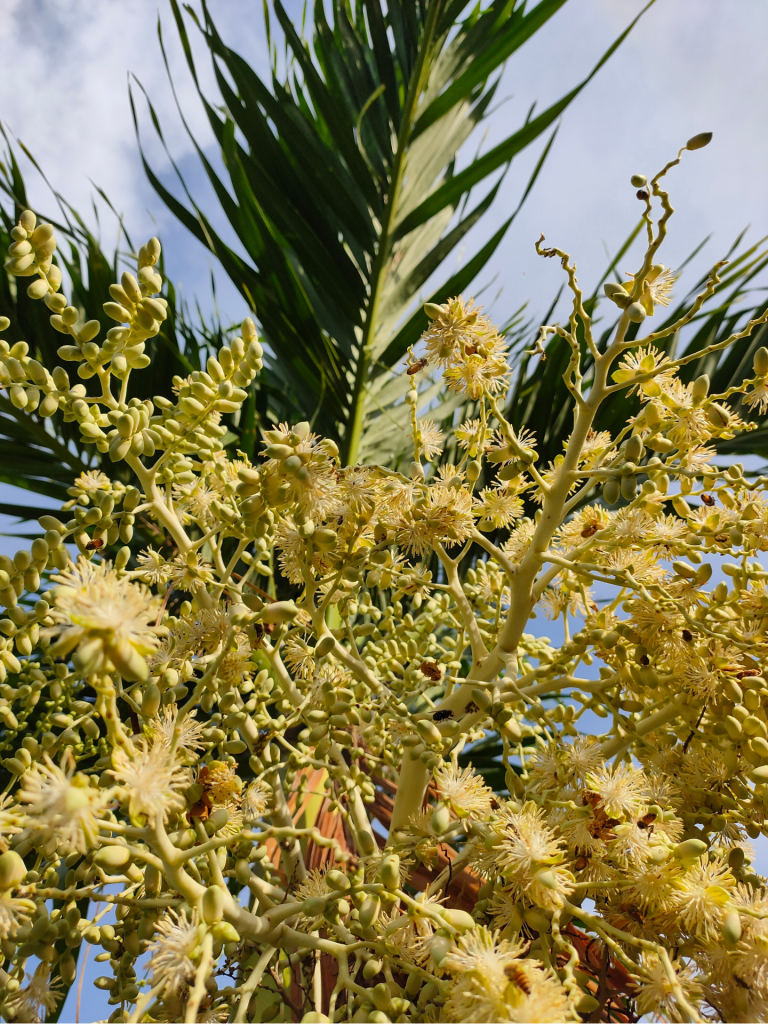Bees and The Trees They Love

Well beyond what most people think bees do for the environment, not only do they pollinate flowers, but trees are a large part of their efforts. Bees require water and food to survive, so eating the fruit or sap that a tree produces makes sense. As bees drink the nectar, get pollen stuck to their legs, and fill up their nectar sacs, they buzz around non-stop. Palm trees, which are especially popular for landscaping in Southern California, seem to have a particular draw for bees and wasps.
What is the Attraction for Bees?
Trees do what they can to attract bees to them because their pollination keeps the tree healthy. The flowers and other blooms have good nutrients for the bees. Trees often give off scents, and bees have incredibly keen olfactory senses and follow smells of maple, fruit, and other fragrances that mean food. Trees need pollination to reproduce, so they are invested in being as attractive as possible to pollinators. Date palms have ultra-sweet white flowers that can be very appealing to bees, and many people chop off the date plan flowers without recognizing that this is very beneficial and if it can stay, it is a good and easy source of food for bees.
Of course, if you or someone in your family is allergic to bees, or the risk of getting stung is high due to the hive’s location or swarming, then take measures to keep safe. If the bees or wasps have created a home in the tree, and it is necessary to remove it, please contact a professional bee removal company with experience removing and relocating the beehive to another area. It is best to ensure the colony as a whole stay connected, and a professional will know how to successfully find a new home in the area so they can continue to provide the benefits to the area without being a pest.
Although bee activity on a palm is excellent for both the bees and the tree, wasps may take the sap and try to take over the tree.
What Makes Pollination So Important?
Trees, flowers, and other living plants need pollination to reproduce and survive. As the pollen sticks to the bee or other pollinator as they drink the nectar, they take it with them when they move on. The pollen from the first plant carries to the second, which causes pollination, and the pollen spreading creates more seeds to grow. In short, fruits and vegetables wouldn’t even be around without pollinators, and bees, although seemingly busy all day buzzing around aimlessly. As they move from bloom to tree to flower again, the pollen that sticks to them continues to pollinate where they go, which is a good thing!
All trees need bees and other pollinators to survive, so when possible, leaving a hive alone if it is not a risk is really the best thing for your plant, flower, and tree health. Additionally, if you have a garden, it will thrive with pollinators hanging around.
Bees Collect Balls of Pollen for the Hive
As mentioned earlier, bees require food for survival, and part of their job is to bring food back to the hive. So, in addition to dragging sticky pollen from one living thing to another, the queen and worker bees also collect little sacs of pollen and take them back to the hive. Male bees are not sac fillers but do their part by carrying pollen from plant to flower to tree simply by having the sticky substance adhere to their hairy little bodies. A full sack of pollen can be up to one-third of a bee’s body weight, holding one million pollen grains! As they fly home, the full pocket hangs off their hind legs. Uninterrupted, a bee will not stop filling his little saddlebag until it is completely full. These sacs, known as corbicula, must make it back to the hive for the baby bees and the hive’s health and keep the queen’s reproductive cycle working as it should.
It is pretty incredible how efficient the pollination process is. Fascinating how masterfully bees and other pollinators know which plants go to and how heavily pollinated plants have distinct colors, smells, and even targets to help the bees find the best seat in the house. Trees are an essential part of pollination, just as much as other plants and flowers. As we know, tree health is integral to environmental health and air quality, so keeping trees healthy is essential, and pollination is a significant part of the process. So, if you have bee activity around a palm or other tree if it is possible to allow it to thrive where it is, consider it. If it is a hazard or causes stress to have it where it is, contact a professional and reputable bee remover to take the hive to another location where it can continue to provide the benefits to the area without being a direct disruption.
